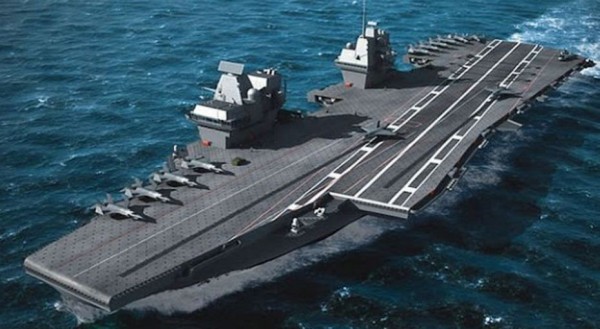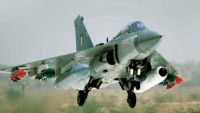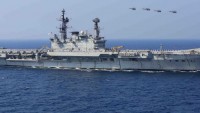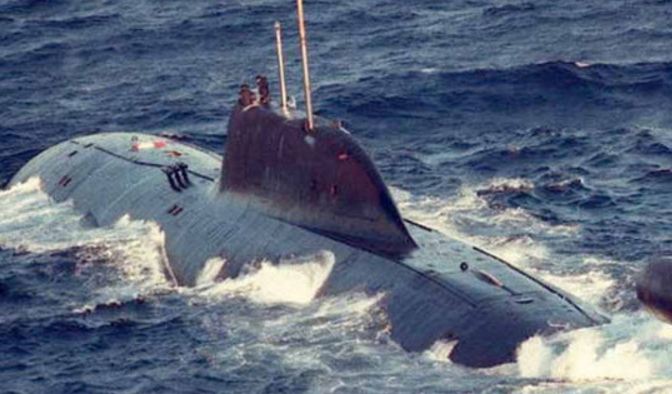Nuclear Powered INS Vishal, India’s First Supercarrier, will Deploy EMALS
| Arthur Dominic Villasanta | | Nov 11, 2016 05:29 AM EST |
(Photo : Cochin Shipyard) INS Vishal (concept drawing).
The guessing game is over. INS Vishal, India's first supercarrier that should see service with the Indian Navy (IN) in the early 2030s, will be nuclear powered.
She will be the first nuclear powered surface warship in the navy and the second in the navy as a whole. The navy's first nuclear powered warship is the Akula II-class nuclear attack submarine INS Chakra (S71). Unlike the INS Vishal, which will be made in India, the Chakra was leased from Russia for a period of 10 years starting in 2012.
Like Us on Facebook
The navy will also lease a second Akula-class submarine from Russia. The Akula I-class submarine expected to arrive in India in 2018 has been identified as the K-322 Kashalot (Sperm Whale), one of only three operational Akula I-class subs in the Russian Navy.
Indian media said sources in the IN revealed important details about INS Vishal, chief among which is will be powered by a nuclear reactor. The INS Vishal will also use a catapult assisted take-off but arrested recovery (CATOBAR) electromagnetic aircraft launch system (EMALS) similar to the system the U.S. Navy plans to deploy on its new Gerald R. Ford-class nuclear powered supercarriers.
The Gerald R. Ford-class is a class of supercarriers being built to replace some of the Navy's existing Nimitz-class carriers.
The decision to use nuclear propulsion, however, will set back the Vishal's entry into IN service from the early 2020s to the early 2030s. IN has no experience in operating a nuclear powered surface warship and will undoubtedly seek assistance from either the United States or France.
The U.S. Navy operates 10 Nimitz-class nuclear powered supercarriers. On the other hand, the French Navy operates the carrier Charles de Gaulle, the only nuclear-powered carrier outside the U.S. Navy. The Charles de Gaulle is the flagship of the French Navy (Marine Nationale).
With a displacement of 65,000 metric tons, INS Vishal is the second ship of the Vikrant-class and the first supercarrier to be built in India.
Her EMALS CATOBAR system will allow her to launch heavier aircraft like larger fighters; unmanned air combat vehicles (UCAVs); turbo-prop airborne early-warning aircraft and aerial refueling tankers. INS Vishal remains under development, however, and it is unclear when her construction will begin.
She will be built by state-owned Cochin Shipyard Limited in Kerala. Vishal is Sanskrit for "immense."
TagsINS Vishal, supercarrier, Indian Navy, Electromagnetic Aircraft Launch System, EMALS, CATOBAR
©2015 Chinatopix All rights reserved. Do not reproduce without permission
EDITOR'S PICKS
-

Did the Trump administration just announce plans for a trade war with ‘hostile’ China and Russia?
-

US Senate passes Taiwan travel bill slammed by China
-

As Yan Sihong’s family grieves, here are other Chinese students who went missing abroad. Some have never been found
-

Beijing blasts Western critics who ‘smear China’ with the term sharp power
-

China Envoy Seeks to Defuse Tensions With U.S. as a Trade War Brews
-

Singapore's Deputy PM Provides Bitcoin Vote of Confidence Amid China's Blanket Bans
-

China warns investors over risks in overseas virtual currency trading
-

Chinese government most trustworthy: survey
-

Kashima Antlers On Course For Back-To-Back Titles
MOST POPULAR
LATEST NEWS
Zhou Yongkang: China's Former Security Chief Sentenced to Life in Prison

China's former Chief of the Ministry of Public Security, Zhou Yongkang, has been given a life sentence after he was found guilty of abusing his office, bribery and deliberately ... Full Article
TRENDING STORY

China Pork Prices Expected to Stabilize As The Supplies Recover

Elephone P9000 Smartphone is now on Sale on Amazon India

There's a Big Chance Cliffhangers Won't Still Be Resolved When Grey's Anatomy Season 13 Returns

Supreme Court Ruled on Samsung vs Apple Dispute for Patent Infringement

Microsoft Surface Pro 5 Rumors and Release Date: What is the Latest?














